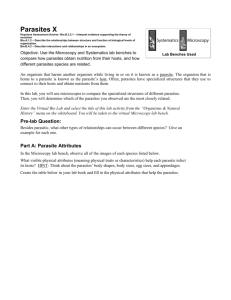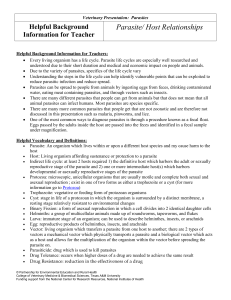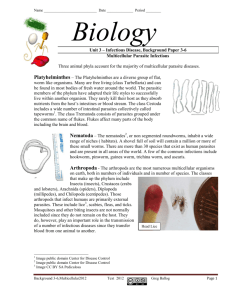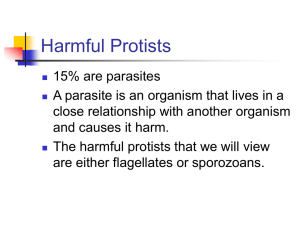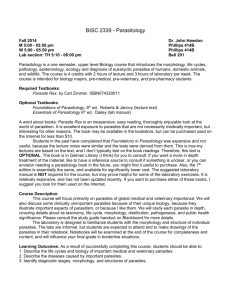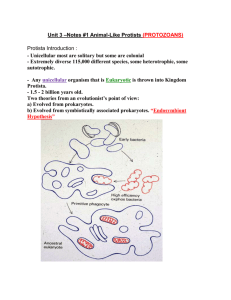Intermediate host - Pharos University in Alexandria
advertisement
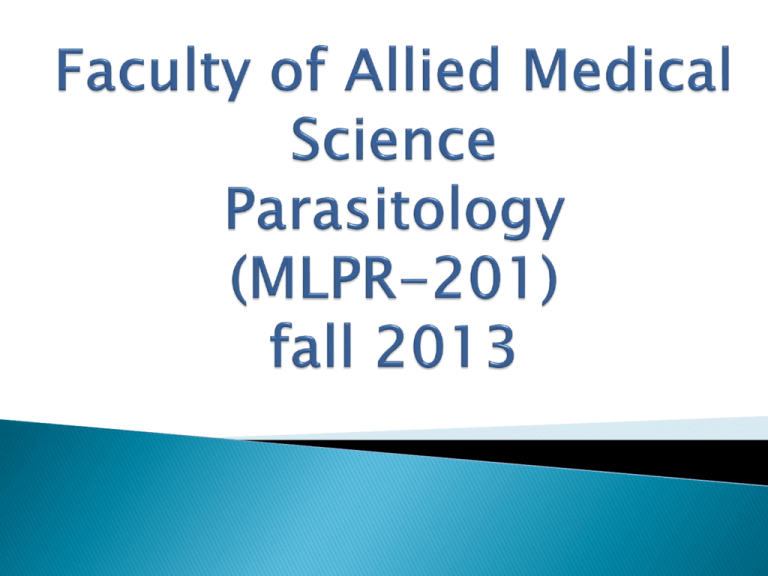
Prof.Dr. Hamdy El-Wakil Professor in Parasitology. Vice Dean in faculty of physiotherapy pharos University 2013M-1434H Human parasitology is the study of those organisms which parasitize humans. According to the very broad definition of parasitology, parasites should include the viruses, bacteria, fungi, protozoa (protista) and metazoa (multi-celled organisms) which infect their host species. However, for historical reasons the first three have been incorporated into the discipline of Microbiology. After completing this course, you should be able to: Discuss how important parasites can be classified according to kingdom and phylum State the meaning of commonly-used terms Describe how parasitic infections affect communities in poor countries and that knowledge of their life cycle is necessary for effective prevention and control Discuss the epidemiology, basic life cycle, clinical presentation, management and control of some important parasitic infections Note: This course will contain many unfamiliar terms. You are NOT expected to remember the classifications and names of all of the different parasite species. The emphasis is on understanding basic concepts and being able to illustrate these with some important examples. After completing this course, you will associated a quiz to assess your learning. 4 Parasite Plasmodium Diseases malaria Soil transmitted helminthes: • Roundworm (Ascaris) • • • Whipworm (Trichuris) Hookworm (Ancylostoma and Necator) No. people infected Deaths/yr 273 million 1.12 million 2 billion 200,000 Pnemonitis, intestinal obstruction Bloody diarrhoea, rectal prolapse Coughing, wheezing, abdominal pain and anaemia Schistosoma Renal tract and intestinal disease 200 million 15,000 Filariae Lymphatic filariasis and elephantiasis 120 million Not fatal but 40 million disfigured or incapacitated Trypanasoma cruzi Chagas disease (cardiovascular) 13 million 14,000 African trypanosomes African sleeping sickness 0.3 – 0.5 million 48,000 Leishamania Cutaneous, mucocutaneous and visceral leishmaniasis 12 million; 2 million new cases/yr 50,000 5 Classification of parasites and vectors Animal Kingdom Sub-Kingdom (Protozoa) Unicellular parasites=kingdom Sub-Kingdom (Metazoa) Multicellular animals Protista Phylum Helminthes : Phylum Arthropods :Phylum Molluscs Subphylum: Sarcodina e.g. Amoeba Phylum: Sarcomastigophora: Subphylum:Mastigophora e.g. Trypansoma Phylum: Ciliphora: Class: Ciliates e.g. Balantidium coli Phylum: Apicomplexa: Class: Sporozoa e.g. Plasmodium Sp. 6 Sub kingdom =kingdom Protista Unicellular Protozoa Phylum Sarcomastigophora further divided into Sub-phylum Sarcodina-- - Genusexamples Speciesexamples Entamoeba E. histolytica Giardia G. lamblia Plasmodium P. falciparum, P. vivax, P. malariae, P. ovale Balantidium B. coli Enterocytozoa E. bieneusi move by pseudopodia Mastigophora move by flagella Apicomplexa no organelle of locomotion Ciliophora move by cillia Microspora Spore-forming 7 Sub kingdom Metazoa Multicellular animals Phylum Class Ascaris (roundworm) Trichuris (whipworm) Ancylostoma (hookworm) Necator (hookworm) Enterobius (pinworm or threadworm) Strongyloides Nematodes Round worms; appear round in cross section, they have body cavities, a straight alimentary canal and an anus Platyhelminthes or Plathelminthes Flat worms; dorsoventrally flattened, no body cavity and, if present, the alimentary canal is blind ending Genus – examples Cestodes Taenia (tapeworm) Adult tapeworms are found in the intestine of their host They have a head (scolex) with sucking organs, a segmented body but no alimentary canal Each body segment is hermaphrodite Trematodes Non-segmented, usually leafshaped, with two suckers but no distinct head They have an alimentary canal and are usually hermaphrodite and leaf shaped Schistosomes are the exception. They are thread-like, and have separate sexes Fasciolopsis (liver fluke) Schistosoma (not leaf shaped!) 8 Although parasitic infections occur globally, the majority occur in tropical regions, where there is poverty, poor sanitation and personal hygiene Often entire communities may be infected with multiple, different organisms which remain untreated because treatment is neither accessible nor affordable Effective prevention and control requires "mass intervention strategies” and intense community education. Examples include: ◦ General improved sanitation: pit latrines, fresh water wells, piped water ◦ Vector control: insecticide impregnated bed nets, spraying of houses with residual insecticides, drainage, landfill ◦ Mass screening and drug administration programmes which may need to be repeated at regular intervals 9 Parasite transmission Indirect (with intermediate hosts) (1) Requiring (2) Requiring one Two intermediate intermediate host hosts Wuchereria bancrofti • H. Hetrophyes Onchocerca volvulus Dracunculus medinensis Trichuris trichiura Fasciolopsis buski Dipylidium caninum (1)Taking a period to become infectious Ascaris lumbricoides Clonorchis sp. Paragonimus westermani (without intermediate host) Loa loa Direct Ancylostoma duodenale Taenia spp Necator americana . Schistoma spp Strongyloides stercoralis . Leishmania spp. Diphyllobothrium Fasciola spp. L. (2) Immediately infective Entamoeba histolytica Giardia lamblia Balantidium coli Trichomonas sp . Hymenolepis nana Enterobius vermicularis Sarcoptes scabiei Pediculus huminus Phthirus pubis 1 0 Eukaryote: a cell with a well-defined chromosome in a membrane-bound nucleus. All parasitic organisms are eukaryotes Prokaryotic organelles Prokaryotes are not as structurally complex as eukaryotes, and were once thought not to have any internal structures enclosed by lipid membranes. Protozoa: unicellular organisms, e.g. Plasmodium (malaria) Metazoa: Multicellular organisms, e.g. helminths (worms) and arthropods (ticks, lice) An endoparasite: “a parasite that lives within another living organism” – e.g. malaria, Giardia An ectoparasite: “a parasite that lives on the external surface of another living organism” – e.g. lice, ticks 1 1 Definitive host: “the organism in which the adult or sexually mature stage of the parasite lives” Intermediate host: “the organism in which the parasite lives during a period of its development only” Zoonosis: “a parasitic disease in which an animal is normally the host - but which also infects man” Vector: “a living carrier (e.g.an arthropod) that transports a pathogenic organism from an infected to a non-infected host”. A typical example is the female Anopheles mosquito that transmits malaria 1 2 Parasitology : Is the science which deals with parasitism, in other hand, it studies the host parasite relationships. Medical parasitology: Deals with the study of parasites of animal origin, belonging to the animal kingdom, and affecting man, the disease they produce, the various methods of their diagnosis, their treatment and finally prevention and control. Parasite : Any organism is considered as a parasite when it lives either on or in another organism to obtain food and shelter without compensation. Definitions: What is ….? Host : Is the living organism which harbours the parasites. Habitat : Is the site in the host where the parasite lives. Parasites vary according to their biological habits. Commensal : If the parasite derives benefit from its host without harming it, it becomes, known as a commensal. Symbiosis: If on the other hand the association between them is so that one cannot live without the help of the other, then this relationship becomes known as symbiosis, but usually a parasite causes injury to its host. Endemic parasite: Maintains a relatively moderate steady level of parasitism in man in a certain area. Also, a parasite is called hyperendemic when its prevalence or incidence is relatively high. Epidemic parasite: When these exist a sharp rise in the prevalence of infection or infestation culminating in an intense outbreak of the disease. Students will prepare an assignment in one of the parasites that have been taken in your lecture. Three points should be covered in his/her assignment: 1. A real infective stage photo of the parasite. 2. Diagnostic stage photo 3. Parasite scientific name, illness or the disease name ,Importance and life cycle.
